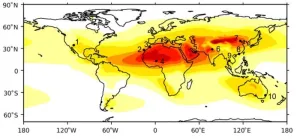(Press-News.org) Planes flying into one of the world's busiest airports are ingesting around 10kg of dust per 1,000 flights - with most of this dust ingested while they are waiting to land, new research has revealed.
Scientists used 17 years of ECMWF atmospheric data and data from the CALIPSO satellite to calculate the quantity of sand and dust swallowed by jet engines at ten major international airports located in desert regions or subject to seasonal dust storms.
The global study, published today (Tuesday, 9 July) in the journal Natural Hazards and Earth System Sciences, found that the largest dust doses were ingested at airports close to the Sahara desert, the Middle East and Northern India, when dry and hot conditions drive large dust storms. Summer flights into Delhi topped the list, ingesting an average of 6.6g per arrival in the run up to monsoon season, and 4.4 grams upon departure.
Delhi is followed by Dubai and Niamey, Niger at 4.3g and 4.7g per arrival respectively, while flights into Beijing swallowed 2.9g on average.
Dr Claire Ryder, from the University of Reading and lead author of the study, said: "Dust and sand are dangerous to aircraft because dust melts to form glassy deposits on blades or hard mineral crusts inside engines. These crusts disrupt airflow and cause overheating, resulting in accelerated engine wear.
“Although the amount of dust ingested per flight is not huge, the amounts quickly add up. A plane consuming five grams of dust per arrival and departure will eat 10kg of dust over 1,000 flights. Planes will consume more dust when they are at lower altitudes waiting to land at, though this depends on the local weather conditions which affect the height of a dust plume in the atmosphere.
“Climate change may lead to a dustier world as temperatures rise and deserts expand, but we cannot say for sure - yet. Climate models do not currently provide a consensus on whether global warming will mean a dustier world, as dust emissions depend on a lot of factors, such as soil moisture, precipitation, surface wind patterns and vegetation cover.
“Ongoing research at the University of Reading is working to improve the ability of climate models to predict dust emissions and transport through the atmosphere.”
Holding patterns
The research team found that aircraft ingest more dust while they are performing holding patterns (which is the formation aircraft assume while pilots are waiting for permission to land). Greater quantities of dust are consumed at low holding patterns of one kilometre, where peak dust concentrations often occur.
Holding patterns of 10-15 minutes at a one-kilometre altitude can lead to more dust ingestion than during the take-off, climb and taxi phases of a flight. For example, at Delhi airport during summer, holding at 1km altitude contributes 50% of total dust ingestion. By changing the holding pattern altitude away from the dusty layers, dust ingestion could be cut by 41%.
The researchers also suggest dust exposure could be reduced by changing flight schedules to avoid peak dust times. Shifting flights at Delhi and Dubai to nighttime could reduce engine dust ingestion by more than 30%.
END
Engine wear risk as planes swallow more dust waiting to land
2024-07-09
ELSE PRESS RELEASES FROM THIS DATE:
Coral reefs: battlegrounds for survival in a changing climate
2024-07-09
(Santa Barbara, Calif.) — Coral reefs, those vibrant underwater cities, stand on the precipice of collapse. While rising ocean temperatures and coral bleaching grab headlines, a new essay in Current Biology reveals a hidden layer of complexity in this fight for survival: the often-overlooked roles of the reefs’ smallest inhabitants.
Scientists have long understood the vital partnership between corals and their symbiotic algae, but work by researchers at UC Santa Barbara and University of Georgia highlights how the fate of entire reefs may hinge ...
Study: Telehealth builds autonomy, trust in treating addiction
2024-07-09
Even as the nation’s opioid epidemic continues to ravage families and communities nationwide — with more than 100,000 Americans dying of drug overdoses each year — stigma remains a barrier for many people accessing treatment for addiction.
A new study from Oregon Health & Science University suggests telehealth may be an important antidote to overcoming stigma and reducing barriers for people seeking out the treatment they need.
The study, published recently in the Harm Reduction Journal, compiled in-depth interviews with 30 people treated for substance use disorder ...
New carbon storage technology is fastest of its kind
2024-07-09
A new way to store carbon captured from the atmosphere developed by researchers from The University of Texas at Austin works much faster than current methods without the harmful chemical accelerants they require.
In new research published in ACS Sustainable Chemistry & Engineering, the team developed a technique for ultrafast formation of carbon dioxide hydrates. These unique ice-like materials can bury carbon dioxide in the ocean, preventing it from being released into the atmosphere.
“We’re staring at a huge challenge — finding a way ...
Socioeconomic status significantly affects fertility treatment outcomes, new study shows
2024-07-09
Novel research, presented today at the ESHRE 40th Annual Meeting in Amsterdam, reveals significant social disparities in achieving live births following assisted reproductive technology (ART) treatment. Women with a research education (PhD) were over three times more likely to achieve a live birth compared to those with a primary school education, while women in the highest income group were twice as likely than those in the lowest income group [1].
Conducted by researchers from the University of Copenhagen and Copenhagen University Hospital (Rigshospitalet), the national, register-based study analysed data from 68,738 women aged 18-45 who underwent ...
IVF and IUI treatment cycles increase across Europe, along with stable pregnancy rates
2024-07-09
Women in Europe are receiving more cycles of in vitro fertilisation (IVF) and intrauterine insemination (IUI), according to data presented today at the ESHRE 40th Annual Meeting in Amsterdam [1].
Preliminary data from the ESHRE European IVF Monitoring (EIM) Consortium [2] reveals a steady and progressive rise in the use of Assisted Reproductive Technology (ART). In 2021, a total of 1 103,633 ART treatment cycles were reported by 1,382 clinics across 37 European countries – a 20% increase from the 919,364 cycles reported in 2020, keeping in mind that this was the year COVID affected the number ...
New 3D imaging method offers promise of better IVF outcomes
2024-07-09
Innovative research, presented today at the ESHRE 40th Annual Meeting in Amsterdam, has introduced a novel 3D imaging model designed to identify features of blastocysts – the early stage of development for an implanted embryo – associated with successful pregnancies. This new approach could transform current blastocyst selection methods, and open avenues for increased pregnancy rates [1].
The shape and structure of blastocysts can predict the success of a pregnancy, aiding blastocyst selection for in vitro fertilisation (IVF). However, selecting ...
Brain & Life® announces new Editor-in-Chief
2024-07-08
MINNEAPOLIS – The American Academy of Neurology (AAN) has named a new editor-in-chief of Brain & Life®, its free patient and caregiver magazine, website and podcast. Sarah Song, MD, MPH, FAAN, an associate professor in the department of neurological sciences at Rush University Medical Center in Chicago, will succeed Editor-in-Chief Orly Avitzur, MD, MBA, FAAN, who will complete her 10-year term on December 31, 2024.
Song, a Fellow of the American Academy of Neurology, will be the third editor-in-chief of Brain & Life since the publication began in ...
University of Cincinnati study: Brain organ plays key role in adult neurogenesis
2024-07-08
University of Cincinnati researchers have pioneered an animal model that sheds light on the role an understudied organ in the brain has in repairing damage caused by stroke.
The research was published July 2 in the Proceedings of the National Academy of Sciences and sought to learn more about how the adult brain generates new neurons to repair damaged tissue.
The research team focused on the choroid plexus, a small organ within brain ventricles that produces the brain’s cerebrospinal fluid (CSF). CSF circulates throughout ...
Small molecules induce trained immunity, opening a new approach to fighting disease
2024-07-08
Vaccines provide a front-line defense against dangerous viruses, training adaptive immune cells to identify and fight specific pathogens.
But innate immune cells — the first responders to any bodily invader — have no such specific long-term memory. Still, scientists have found that they can reprogram these cells to be even better at their jobs, potentially fighting off seasonal scourges like the common cold or even new viral diseases for which vaccines have not yet been developed.
A University of Chicago Pritzker School of Molecular Engineering (PME) team has found several small molecule candidates that induce this trained immunity without the ...
Erasing “bad memories” to improve long term Parkinson’s disease treatment
2024-07-08
BIRMINGHAM, Ala. — Common treatments for Parkinson’s disease can address short-term symptoms but can also cause extensive problems for patients in the long run. Namely, treatments can cause dyskinesia, a form of uncontrollable movements and postures.
In a recent study published in The Journal of Neuroscience, researchers at the University of Alabama at Birmingham took a different approach to dyskinesia and treated it like a “bad motor memory.” They found that blocking a protein called Activin A could halt dyskinesia symptoms ...


